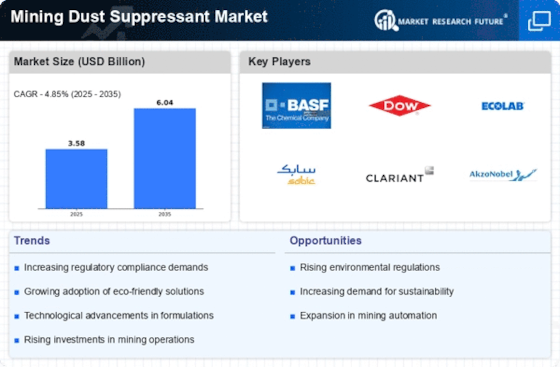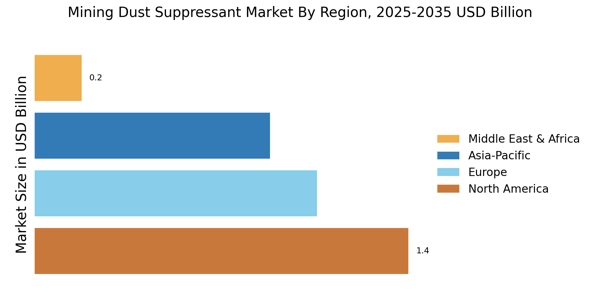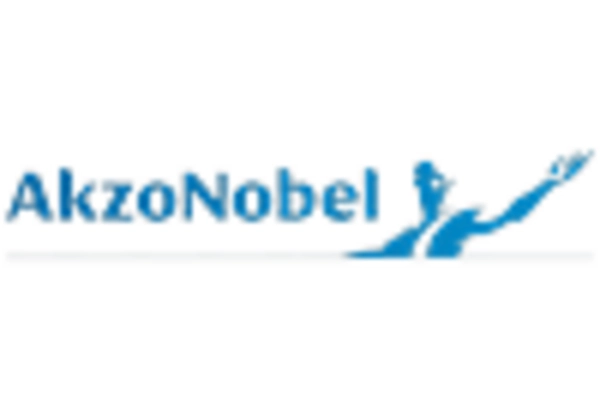Technological Innovations
Technological advancements are playing a pivotal role in shaping the Mining Dust Suppressant Market. Innovations in formulation and application techniques are leading to the development of more effective and environmentally friendly dust suppressants. For example, the introduction of polymer-based dust suppressants has shown promising results in reducing airborne particulate matter. These innovations not only enhance the efficacy of dust control but also align with the growing emphasis on sustainability within the mining sector. The market is projected to witness a compound annual growth rate of approximately 5% over the next few years, driven by these technological advancements. As mining companies seek to optimize their operations and reduce environmental impact, the demand for innovative dust suppression solutions is likely to increase, thereby bolstering the Mining Dust Suppressant Market.
Health and Safety Concerns
Health and safety considerations are increasingly influencing the Mining Dust Suppressant Market. The mining sector is inherently hazardous, and the presence of dust can exacerbate health risks for workers. Chronic exposure to dust can lead to respiratory diseases, which has prompted mining companies to prioritize the implementation of effective dust suppression strategies. This focus on health and safety is not only a moral obligation but also a legal requirement in many jurisdictions. As a result, mining companies are investing in dust suppressants to create safer working environments. The market for dust suppressants is expected to grow as companies recognize the importance of protecting their workforce. Furthermore, the potential for reduced healthcare costs associated with improved worker health adds an economic incentive for the adoption of dust suppression technologies within the Mining Dust Suppressant Market.
Regulatory Compliance Pressure
The Mining Dust Suppressant Market is experiencing heightened pressure due to stringent regulatory frameworks aimed at controlling dust emissions. Governments are increasingly implementing regulations that mandate the use of effective dust suppression methods in mining operations. This regulatory compliance is not merely a formality; it is a critical factor driving the adoption of dust suppressants. For instance, the United States Environmental Protection Agency has established guidelines that necessitate the use of dust control measures in mining activities. As a result, mining companies are compelled to invest in advanced dust suppression technologies to meet these regulations, thereby propelling the Mining Dust Suppressant Market forward. The financial implications of non-compliance can be severe, including hefty fines and operational shutdowns, which further incentivizes the adoption of dust suppressants.
Economic Growth in Emerging Markets
Economic growth in emerging markets is significantly impacting the Mining Dust Suppressant Market. As countries in Asia, Africa, and South America continue to develop their mining sectors, the demand for effective dust suppression solutions is on the rise. These regions are witnessing an increase in mining activities, driven by the need for natural resources to support their growing economies. Consequently, mining companies in these areas are increasingly recognizing the importance of dust control measures to comply with regulations and ensure worker safety. The Mining Dust Suppressant Market is expected to benefit from this trend, as investments in mining infrastructure and technology are likely to lead to higher demand for dust suppressants. Furthermore, the potential for increased foreign investment in these emerging markets may further stimulate growth in the dust suppression sector.
Environmental Sustainability Initiatives
The Mining Dust Suppressant Market is increasingly influenced by the global push for environmental sustainability. Mining operations are often scrutinized for their environmental impact, particularly concerning dust emissions. As stakeholders, including investors and communities, demand more sustainable practices, mining companies are compelled to adopt dust suppression solutions that minimize their ecological footprint. The use of biodegradable and non-toxic dust suppressants is gaining traction as companies seek to align their operations with sustainability goals. This shift not only enhances the public image of mining companies but also opens up new market opportunities. The increasing awareness of environmental issues is likely to drive the demand for innovative dust suppression solutions, thereby fostering growth within the Mining Dust Suppressant Market. Companies that proactively embrace sustainability are likely to gain a competitive edge in the evolving market landscape.


















Leave a Comment